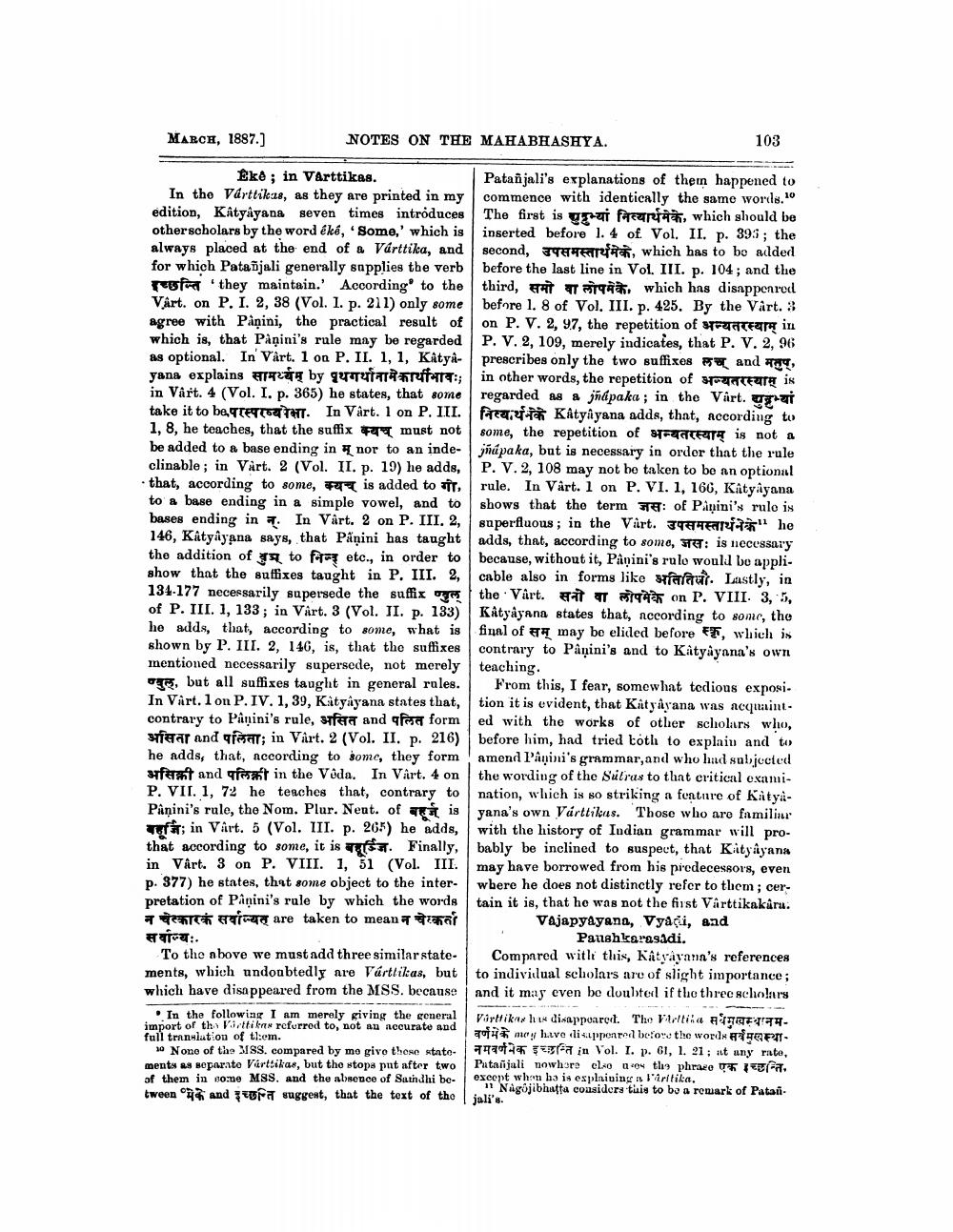________________
MARCH, 1887.)
NOTES ON THE MAHABHASHYA.
103
Eke; in Verttikas.
Patanjali's explanations of them happened to In the Varttikas, as they are printed in my commence with identically the same words. edition, Katyayana seven times introduces The first is शुभ्यां नित्यार्थमेके, which should be otherscholars by the word éké, 'Some,' which is inserted before 1. 4 of. Vol. II. p. 393; the always placed at the end of a Várttika, and second, T a ch, which has to be added for which Patañjali generally supplies the verb before the last line in Vol. III. p. 104; and the refrat they maintain.' According to the third, AT TAT which has disappeared Vårt. on P. I. 2, 38 (Vol. I. p. 211) only some before 1. 8 of Vol. III. p. 425. By the Vart. 3 agree with Panini, the practical result of on P. V. 2, 97, the repetition of YETET in which is, that Paņini's rule may be regarded P. V. 2, 109, merely indicates, that P. V. 2, 96 as optional. In' Vårt. 1 on P. II. 1, 1, Katya- prescribes only the two suffixes and fall, yana explains सामर्थ्यम् by पृथगर्थानामेका भावः; in other words, the repetition of अन्यतरस्याम् is in Vart. 4 (Vol. I. p. 365) he states, that some regarded as & jnápaka ; in the Virt. 2 take it to be. TETEHT. In Vårt. 1 on P. III. facit Katyayana adds, that, according to 1, 8, he teaches, that the suffix 46 must not some, the repetition of STFEATRITE is not a be added to a base ending in nor to an inde- jñápaka, but is necessary in order that the rule clinable; in Vårt. 2 (Vol. II. p. 19) he adds, P. V.2, 108 may not be taken to be an optional that, according to some, is added to tr, rule. In Vårt. 1 on P. VI. 1, 166, Katyayana to a base ending in a simple vowel, and to shows that the term : of Panini's rulo is bases ending in . In Vårt. 2 on P. III. 2, superfluous; in the Virt. TETHETUAR" he 146, Katyayana says, that Påņini has taught adds, that, according to some, T: is necessary the addition of sto fara etc., in order to because, without it, Pâņini's rulo would be applishow that the suffixes taught in P. III. 2, cable also in forms like faut. Lastly, in 134-177 necessarily supersede the suffix un the Vart.
1947 on P. VIII. 3, 5, of P. III. 1, 133; in Vårt. 3 (Vol. II. p. 133) Katyayana states that, nccording to some, the he adds, that, according to some, what is final of g may be elided before ET, which is shown by P. III. 2, 146, is, that the suffixes contrary to Pâņini's and to Katyayana's own mentioned necessarily supersede, not merely | teaching,
e, but all suffixes taught in general rules. From this, I fear, somewhat tedious exposi. In Vart. 1 on P.IV. 1, 39, Katyayana states that, tion it is evident, that Katyayana was noquaintcontrary to Panini's rule, fear and ope form ed with the works of other scholars who,
fear and fast; in Vart. 2 (Vol. II. p. 216) before him, had tried toth to explain and to he adds, that, according to some, they form amend Panini's grammar, and who had subjected
femnt and fast in the Vôda. In Vart. 4 on the wording of the Sutras to that critical examiP. VII. 1, 72 he teaches that, contrary to nation, which is so striking a feature of KatyaPanini's rule, the Nom. Plur. Nent. of quit is yana's own Várttikas. Those who aro familie Tofar; in Vårt. 5 (Vol. III. p. 265) he adds, with the history of Indian grammar will prothat according to some, it is wats. Finally, bably be inclined to suspect, that Kityayana in Vârt. 3 on P. VIII. 1, 51 (Vol. III. may have borrowed from his predecessors, even p. 377) he states, that some object to the inter- where he does not distinctly refer to them; cerpretation of Panini's rule by which the words tain it is, that he was not the first Värttikakäru. rarea are taken to mean it waar
Vajapyayana, Vyaci, and :.
Paushkarasadi. To thonbove we must add three similarstate. Compared with this, Katyayana's references ments, which undoubtedly are várttikas, but to individual scholars are of slight importance; which have disappeared from the MSS. because and it may even bo doulsted if the three scholars
. In the following I am merely giving the general Virtlik x h* disappearoit. The Villtiha agarimport of the Vinttikan refurrod to, not an accurate and
e morro , O Accurate and full translation of tl:em.
07 mey have dieuppenrod betore the words #99F
time 10 None of the SS. compared by me give these state
qata era in Vol. I. p. 61, 1. 21; at any rate, ments as separato Vart ikas, but the stopa put after two Patanjali nowhere cleo 4 the phrace T e n of them in nome MSS. and the absence of Sathdhi be
except who ha is esplaivinga iritika.
Nagojibhatta considers tuis to bo a romark of Patan. tween 0 and ora suggest, that the text of tho jali's.
m




